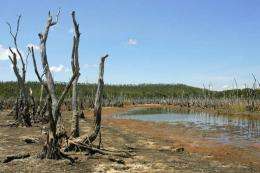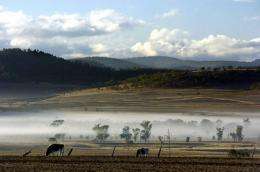Australia to become hotter, drier: climate report

Australia's climate is warming at an alarming rate and is set to become drier despite recent record floods, scientists said in a report that warns of increased drought and fiercer storms.
The country has seen annual average daily temperatures rise by 0.9 degrees Celsius since 1911, with each decade since the 1950s warmer than the last, the report by government science body CSIRO and the Bureau of Meteorology said.
The national climate snapshot found that temperatures will jump again -- by between 1.0 and 5.0 degrees Celsius by 2070 -- if global greenhouse emissions remain within the range of expectations.
"Global changes of this magnitude happen very rarely. They happen when asteroids strike, they happen when there's planetary volcanic activity," said Karl Braganza, the head of climate monitoring at the Bureau of Meteorology.
"They're happening now because we're digging up fossil fuels and basically burning them all. And we're doing that very, very rapidly," he told ABC Radio.

Australia is known for its droughts, cyclones, bushfires and floods and the State of the Climate 2012 found that while a spike in the frequency of droughts was expected in the south, there was also likely to be an increase in the intensity of rainfall events -- such as the Queensland floods.
Eastern Australia faced huge floods in late 2010 and early 2011, which swamped an area as large as France and Germany combined, destroying farms and coal mines and claiming more than 30 lives.
The inundations were caused by La Nina events, which brought the highest two-year average rainfall total on record in 2010 and 2011 -- and Australia's coolest years since 2001.
But the report said they did not alter the overall picture of warming.
"The warming trends observed around Australia are consistent with global-scale warming that has been measured during recent decades," it said.
The report said average temperatures in Australia are projected to rise by 0.6-1.5 degrees Celsius by 2030 when compared with the climate of 1980 to 1999.
It added it was clear that increasing greenhouse gas concentrations -- which reached a new high in 2011 -- would result in "significant further global warming".
"Unless greenhouse gas emissions decrease, we expect to see the temperature of the atmosphere and the oceans continue to warm and sea levels continue to rise at current or even higher rates than reported here," it said.
(c) 2012 AFP

















